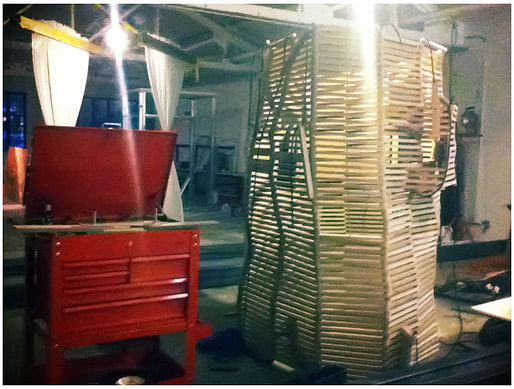
Oct '11 - May '13
Today, November, 11th, we have our regular crit session with Thomas Gardner. As you can read on his bio, he is a Cranbrook grad who has practiced & taught in Detroit, before moving to Providence and now is teaching in RISD.
Four people were supposed to take the limelight today. However, Doug ‘the Savior’ Skidmore had to install his piece for the big 11.11.11 night. He bailed.
I'm writing about the discussion resulted from three people presented. Brian with his modular MDF building system, Si Yang with her housing for the elderly scheme sited on a plot in Northeastern mainland China, and Tania with her right index finger rings, can be considered as a nice portrait of what we are doing in the department. Just consider the range of scales & how we need to address different particular issues brought in by each of them.


What interests me about the conversation we had is how different specific scales could feed different information back. In Cranbrook, where building in 1:1 scale is followed “religiously” (Thomas' words), it is refreshing to repose questions like this. It puts our intentions as architects back into play. Our choice of scale in which we are working constitutes the extents and limitations of the evolution of our ideas. It is not a question of value judgement, where one is better from the other. All scales work. They just do differently.
It brings me to the notion of method. My believe in architecture not as buildings/objects, but as practice, extends itself to being familiar with many methods at the same time, and picking out the right one for each certain purposes. Just by not being fully aware of what method of working one is working in, I have seen many ideas not being developed into its full potential during my nearly-two-months in the academy (and I'm not speaking exclusively about the Architecture Department).
In Cranbrook, where we basically can do whatever the f**k we want, the notion of method becomes extremely critical for me. This notion has rarely been addressed. Understanding not only in the object one is (re)presenting, but more importantly in how s/he could get there in the first place, does justice not only to the presenter, but to the audience. Empathy and ability to listen are honed this way. One thing about art school: voices are in abundance, it's becoming difficult to differentiate sounds from noises. Maybe it has become too deafening, that people have stopped to listen.
Another question then arises: if almost everyone seems to be fine with how things are going (meaning that this is actually what they are looking for), would I be imposing my own belief in questioning the present condition? Wouldn't I also be another noise-creating pair of lips, when actually another silent pair of ears is what everyone need?
Dillema. Nice. It's always a good start.
A school blog on Arch Dept, Cranbrook Academy of Art. By farid rakun, admitted Fall 2011.
1 Comment
rule #2 of jack keroauc's rules of spontaneous prose:
"Submissive to everything, open, listening."
actually, i think all the list is studio pertinent.
http://onr.com/user/icyo/rules/rules.htm
Block this user
Are you sure you want to block this user and hide all related comments throughout the site?
Archinect
This is your first comment on Archinect. Your comment will be visible once approved.